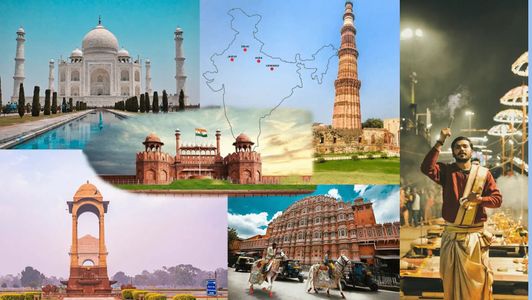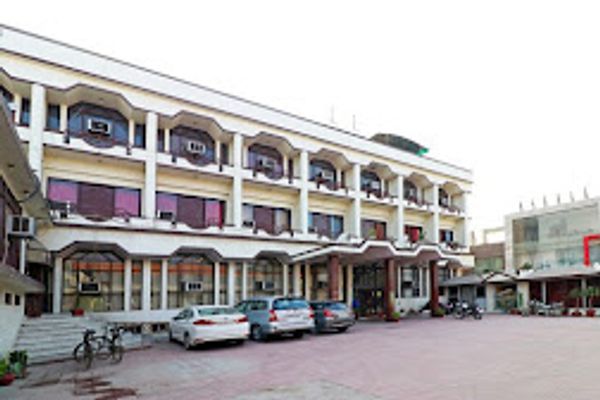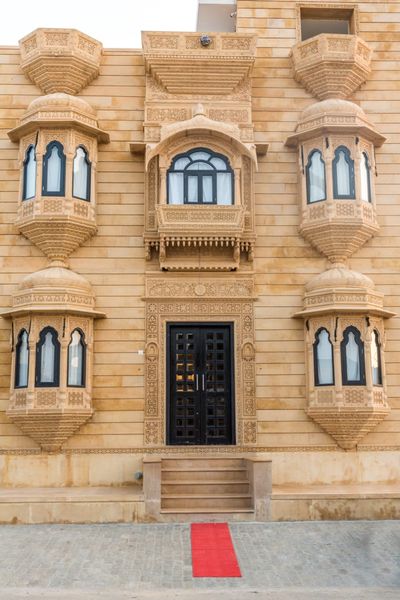Golden Triangle Tour with Varanasi
 Rawat Sikhar
24 Jan, 2025
12 mins read
76
Rawat Sikhar
24 Jan, 2025
12 mins read
76

India, a land of mesmerizing diversity, offers an array of experiences that captivate the imagination of travelers from across the globe. Among the most popular and enriching journeys in India is the Golden Triangle Tour, a well-trodden path that connects three of India’s most iconic cities: Delhi, Agra, and Jaipur. This circuit offers an exploration into India’s rich history, royal architecture, and vibrant culture. But there’s one destination that, when added to this classical route, transforms the experience into something deeply spiritual and profound: Varanasi.
Incorporating Varanasi into the Golden Triangle Tour adds an entirely new layer to the journey—one that delves into the heart of India’s spiritual essence. As one of the oldest cities in the world and the spiritual capital of India, Varanasi offers travelers a chance to immerse themselves in a culture steeped in ancient traditions, rituals, and a profound connection to the sacred. This article explores the Golden Triangle Tour with Varanasi, delving into its historical, cultural, and spiritual significance.
Delhi: The Confluence of History and Modernity
Delhi, the bustling capital city of India, is the perfect starting point for the Golden Triangle Tour. A dynamic blend of ancient history and modernity, Delhi offers a rich tapestry of landmarks, each representing a different era of India’s evolution. From the Mughal period to the colonial era, and the post-independence era, Delhi tells a story of resilience, transformation, and cultural richness.
Historical Landmarks
The iconic Red Fort, built by the Mughal emperor Shah Jahan, stands as a testament to Mughal architectural brilliance. The massive fort, with its imposing red sandstone walls, was once the seat of the Mughal emperors. Nearby, the Jama Masjid, one of the largest mosques in India, offers a glimpse into the grandeur of Mughal-era religious structures.
Another must-visit historical site is Humayun’s Tomb, a precursor to the Taj Mahal, offering a glimpse into Mughal architecture that is beautifully symmetrical and serene. The Qutub Minar, another UNESCO World Heritage site, is the tallest brick minaret in the world and a symbol of the power and glory of the Delhi Sultanate.
Modern Delhi
While Delhi is undeniably historical, it is also a vibrant, modern metropolis. The Lotus Temple, with its unique lotus-shaped design, offers a peaceful space for reflection and worship for people of all faiths. Connaught Place, the heart of Delhi’s shopping and dining scene, offers travelers a taste of modern India with its upscale shops, restaurants, and cafes.
Exploring Delhi is an experience that contrasts the old with the new, giving travelers a comprehensive understanding of India’s journey from its ancient roots to its modern-day identity.
Agra: The Mughal Glory
Agra, a city that exudes timeless romance and grandeur, is the second stop on the Golden Triangle Tour. It is home to one of the most famous monuments in the world: the Taj Mahal. Built by Emperor Shah Jahan in memory of his beloved wife Mumtaz Mahal, the Taj Mahal is a stunning white marble mausoleum that has captured the hearts of millions of travelers since it was completed in 1653.
The Taj Mahal
The Taj Mahal is not just a monument; it’s a symbol of eternal love. Its stunning symmetry, intricate carvings, and breathtaking beauty leave visitors in awe. The monument’s grandeur is matched only by its serene location, overlooking a reflective pool with lush gardens surrounding it. A visit to the Taj Mahal is a must for anyone on the Golden Triangle Tour, and it’s particularly magical at sunrise and sunset, when the changing light creates a mesmerizing effect on the marble surface.
Agra Fort and Fatehpur Sikri
While the Taj Mahal is the star attraction, Agra is also home to other remarkable Mughal landmarks. Agra Fort, another UNESCO World Heritage site, is an imposing red sandstone fort that served as the residence of the Mughal emperors. Inside, you’ll find intricate Mughal architecture, expansive courtyards, and beautiful palaces, including the Jahangir Palace and the Diwan-i-Khas.
A short drive from Agra will take you to Fatehpur Sikri, the abandoned Mughal capital, built by Emperor Akbar in the late 16th century. The site is an architectural marvel, with the grand Jama Masjid, Diwan-i-Khas, and Panch Mahal offering a glimpse into the opulence of the Mughal court.
Jaipur: The Pink City and Royal Heritage
Jaipur, the capital of Rajasthan, is the third city on the Golden Triangle Tour and offers a unique experience steeped in royal history, vibrant culture, and traditional Rajasthani hospitality. Known as the “Pink City” because of the distinct pink hue of its buildings, Jaipur is a city that blends old-world charm with royal grandeur.
Amber Fort and City Palace
A visit to Jaipur is incomplete without exploring Amber Fort, a magnificent fortress perched on a hilltop. The fort’s stunning architecture, intricate carvings, and beautiful courtyards are a testament to Rajput architecture at its finest. Riding an elephant up to the fort adds a sense of royalty to the experience.
The City Palace, a majestic complex that houses museums, courtyards, and palaces, offers insight into the life of Jaipur’s royal family. The palace is a harmonious blend of Mughal and Rajput architecture and is still home to the royal family.
Jantar Mantar and Hawa Mahal
Jaipur is also home to the Jantar Mantar, an astronomical observatory built by Maharaja Jai Singh II. The observatory houses large instruments used for measuring time, tracking celestial bodies, and studying the stars. Hawa Mahal, the “Palace of Winds,” is another architectural gem. The intricately designed façade of the palace, with its 953 small windows, was built to allow the royal ladies to observe the street life without being seen.
Jaipur’s rich heritage, royal palaces, and vibrant bazaars make it a perfect destination for those interested in India’s royal past.
Varanasi: The Spiritual Heart of India
While Delhi, Agra, and Jaipur offer a fascinating look into India’s history, culture, and architecture, it is Varanasi that provides a unique spiritual dimension to the Golden Triangle Tour. Located on the banks of the holy Ganges River, Varanasi is often referred to as the spiritual capital of India and is one of the oldest continuously inhabited cities in the world.
The Sacred Ganges
Varanasi’s significance lies in its deep connection to Hinduism. The Ganges River, regarded as the most sacred river in Hinduism, is central to the city’s spiritual life. Pilgrims from all over India and beyond come to Varanasi to bathe in the Ganges, believing it purifies the soul and washes away sins. The ghats (steps leading down to the river) are an integral part of Varanasi’s landscape, and each ghat has its own unique history and significance.
Evening Aarti
One of the most awe-inspiring experiences in Varanasi is the evening Aarti ceremony, which takes place on the ghats of the Ganges. Devotees gather as priests perform a synchronized ritual, offering prayers with fire, incense, and music to the river goddess Ganga. The sight of the glowing lamps, the sound of bells, and the chanting of mantras creates an atmosphere of devotion and reverence that is unlike anything else.
Temples and Spiritual Sites
Varanasi is home to some of the most important Hindu temples, including the Kashi Vishwanath Temple, dedicated to Lord Shiva, and the Sankat Mochan Temple, dedicated to Lord Hanuman. These temples are not only places of worship but also centers of cultural and spiritual life. In Varanasi, life and death are intimately connected. The Manikarnika Ghat, the main cremation ghat, is where many Hindus come to be cremated, as it is believed that dying in Varanasi and being cremated on the banks of the Ganges leads to liberation (moksha).
Buddhism and Varanasi
Though primarily associated with Hinduism, Varanasi also has a connection to Buddhism. Just outside the city lies Sarnath, the place where Lord Buddha gave his first sermon after attaining enlightenment. The Dhamek Stupa at Sarnath marks the spot where Buddha preached the Dharma. Pilgrims and visitors to Varanasi often take a day trip to Sarnath to witness the peaceful surroundings and historical significance of the site.
The Spiritual Journey
The Golden Triangle Tour with Varanasi is not just a journey through India’s history and culture, but also a journey into the spiritual heart of the country. Varanasi, with its timeless rituals and deep religious significance, offers travelers a rare opportunity to experience spirituality in its purest form. Whether you’re seeking solace, enlightenment, or simply a deeper understanding of India’s diverse traditions, Varanasi offers a profound experience that will stay with you long after you’ve left.
Conclusion
The Golden Triangle Tour with Varanasi is a remarkable journey through the rich history, vibrant culture, and spiritual soul of India. From the historical grandeur of Delhi and Agra to the royal heritage of Jaipur and the spiritual depth of Varanasi, this tour provides a well-rounded exploration of India’s most iconic destinations. Whether you’re fascinated by history, captivated by culture, or moved by spirituality, this tour offers something for everyone, leaving travelers with unforgettable memories and a deeper connection to one of the world’s most fascinating countries.
Written By:
Rawat Sikhar



Hotels at your convenience
Now choose your stay according to your preference. From finding a place for your dream destination or a mere weekend getaway to business accommodations or brief stay, we have got you covered. Explore hotels as per your mood.


